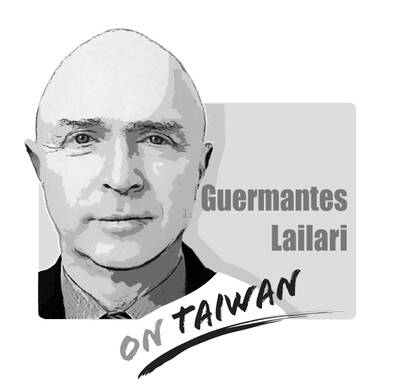Enoch Wu (吳怡農), the Democratic Progressive Party’s candidate in Taipei’s legislative by-election, has proposed relocating Taipei International Airport (Songshan airport) to coincide with the completion of Taiwan Taoyuan International Airport’s third runway.
Wu’s proposal is a welcome change from mudslinging and is worthy of discussion.
A map on the Civil Aeronautics Administration Web site shows that the 213-hectare Songshan airport is surrounded by a zone of “airport restricted construction control” that extends 31km from east to west and 12km from north to south at its widest point. This zone covers 3,000 hectares, which is about 272 times the 11-hectare Sun Yat-sen Memorial Hall and park, 120 times the 25-hectare Chiang Kai-shek Memorial Hall and park, and 116 times the size of Daan Forest Park (大安森林公園).
Songshan airport’s runway is 2,605m long, which is shorter than the 2,800m needed for a Boeing 747 to take off and land. The west end of the runway is only 1m above sea level, making it prone to flooding and difficult to drain.
To ensure nighttime peace and quiet for nearby residents, aircraft can only take off and land from 6am to 11pm. The prevailing east wind in the Taipei Basin makes it hard to land and brake in a westerly direction, while pilots using the east to west orientation of the runway often run into the problem of sun glare.
On Feb. 4, 2015, TransAsia Airways Flight 235 from Songshan airport to Kinmen County experienced engine failure and crashed into the Keelung River in Taipei’s Nangang District (南港) shortly after taking off from the east end of the runway, killing 43 people. On Aug. 12, 1970, China Airlines Flight 206 from Hualien to Songshan airport crashed into woodland while approaching from the west, killing 14 people.
Airports in cities are close to densely populated areas, so any aircraft accident is likely to cause an even greater disaster.
Passenger planes are developing higher passenger capacities and more efficient fuel consumption. The layout and operation of major urban infrastructure facilities such as airports need to first consider safety, and have resilient disaster prevention plans.
There should be high-speed, high-capacity mass rapid transport systems to carry passengers to suburban airports that meet safety standards.
Reviewing Songshan airport, which was built a century ago under Japanese rule, and relocating its services to Taoyuan would set an example for relocating airports in Kaohsiung, Tainan and Hualien County.
Lai Ming-huang is an engineer with a doctorate from National Cheng Kung University.
Translated by Julian Clegg
Congratulations to China’s working class — they have officially entered the “Livestock Feed 2.0” era. While others are still researching how to achieve healthy and balanced diets, China has already evolved to the point where it does not matter whether you are actually eating food, as long as you can swallow it. There is no need for cooking, chewing or making decisions — just tear open a package, add some hot water and in a short three minutes you have something that can keep you alive for at least another six hours. This is not science fiction — it is reality.

A foreign colleague of mine asked me recently, “What is a safe distance from potential People’s Liberation Army (PLA) Rocket Force’s (PLARF) Taiwan targets?” This article will answer this question and help people living in Taiwan have a deeper understanding of the threat. Why is it important to understand PLA/PLARF targeting strategy? According to RAND analysis, the PLA’s “systems destruction warfare” focuses on crippling an adversary’s operational system by targeting its networks, especially leadership, command and control (C2) nodes, sensors, and information hubs. Admiral Samuel Paparo, commander of US Indo-Pacific Command, noted in his 15 May 2025 Sedona Forum keynote speech that, as
In a world increasingly defined by unpredictability, two actors stand out as islands of stability: Europe and Taiwan. One, a sprawling union of democracies, but under immense pressure, grappling with a geopolitical reality it was not originally designed for. The other, a vibrant, resilient democracy thriving as a technological global leader, but living under a growing existential threat. In response to rising uncertainties, they are both seeking resilience and learning to better position themselves. It is now time they recognize each other not just as partners of convenience, but as strategic and indispensable lifelines. The US, long seen as the anchor
Kinmen County’s political geography is provocative in and of itself. A pair of islets running up abreast the Chinese mainland, just 20 minutes by ferry from the Chinese city of Xiamen, Kinmen remains under the Taiwanese government’s control, after China’s failed invasion attempt in 1949. The provocative nature of Kinmen’s existence, along with the Matsu Islands off the coast of China’s Fuzhou City, has led to no shortage of outrageous takes and analyses in foreign media either fearmongering of a Chinese invasion or using these accidents of history to somehow understand Taiwan. Every few months a foreign reporter goes to